
Barge nowadays generally refers to a flat-bottomed inland waterway vessel which does not have its own means of mechanical propulsion. The first modern barges were pulled by tugs, but nowadays most are pushed by pusher boats, or other vessels. The term barge has a rich history, and therefore there are many other types of barges.
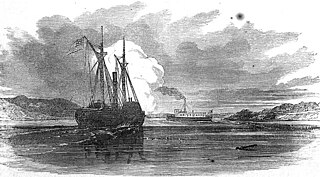
A tugboat or tug is a marine vessel that manoeuvres other vessels by pushing or pulling them, with direct contact or a tow line. These boats typically tug ships in circumstances where they cannot or should not move under their own power, such as in crowded harbour or narrow canals, or cannot move at all, such as barges, disabled ships, log rafts, or oil platforms. Some are ocean-going, some are icebreakers or salvage tugs. Early models were powered by steam engines, long ago superseded by diesel engines. Many have deluge gun water jets, which help in firefighting, especially in harbours.

A container ship is a cargo ship that carries all of its load in truck-size intermodal containers, in a technique called containerization. Container ships are a common means of commercial intermodal freight transport and now carry most seagoing non-bulk cargo.
The Port of London is that part of the River Thames in England lying between Teddington Lock and the defined boundary with the North Sea and including any associated docks. Once the largest port in the world, it was the United Kingdom's largest port as of 2020. Usage is largely governed by the Port of London Authority ("PLA"), a public trust established in 1908; while mainly responsible for coordination and enforcement of activities it also has some minor operations of its own.

Intermodal freight transport involves the transportation of freight in an intermodal container or vehicle, using multiple modes of transportation, without any handling of the freight itself when changing modes. The method reduces cargo handling, and so improves security, reduces damage and loss, and allows freight to be transported faster. Reduced costs over road trucking is the key benefit for inter-continental use. This may be offset by reduced timings for road transport over shorter distances.

Transshipment, trans-shipment or transhipment is the shipment of goods or containers to an intermediate destination, then to another destination.
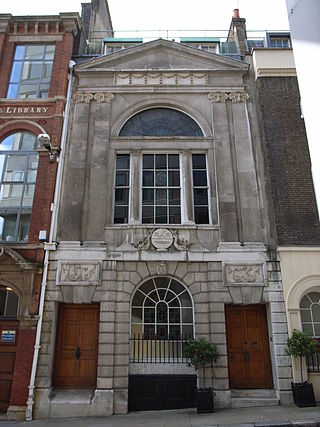
A lighterman is a worker who operates a lighter, a type of flat-bottomed barge, which may be powered or unpowered. In the latter case, today it is usually moved by a powered tug. The term is particularly associated with the highly skilled men who operated the unpowered lighters moved by oar and water currents in the Port of London.

A sidelifter is a specialised vehicle or semi-trailer used to hoist and transport ISO standard intermodal containers over longer distances.

USS Lynx (AK-100) was a Crater-class cargo ship commissioned by the US Navy for service in World War II. Lynx was the third US Navy vessel to bear the name, but unlike previous ships this one was named after the constellation Lynx. She was responsible for delivering troops, goods and equipment to locations in the Asiatic-Pacific Theater.

The Port of Hong Kong, located by the South China Sea, is a deepwater seaport dominated by trade in containerised manufactured products, and to a lesser extent raw materials and passengers. A key factor in the economic development of Hong Kong, the natural shelter and deep waters of Victoria Harbour provide ideal conditions for berthing and the handling of all types of vessels. It is one of the busiest ports in the world, in the three categories of shipping movements, cargo handled and passengers carried.

A dry bulk cargo barge is a barge designed to carry freight such as coal, finished steel or its ingredients, grain, sand or gravel, or similar materials. Barges are usually constructed of steel. They have an outer hull, an internal void that is fitted with heavy struts and cross braces or scantlings, and an internal cargo box. The outer hull of a barge can come in one of two configurations. A rake barge has a curved bow to provide less resistance when being pushed and is usually placed at the head of the tow. A box barge is usually placed in the center and rear of the tow and can hold more cargo.

Orient Overseas Container Line, commonly known as OOCL, is a container shipping and logistics service company with headquarters in Hong Kong. The company is incorporated in Hong Kong as Orient Overseas Container Line Limited and separately incorporated as Orient Overseas Container Line Inc. in Liberia. The latter was also re-domiciled to the Marshall Islands.
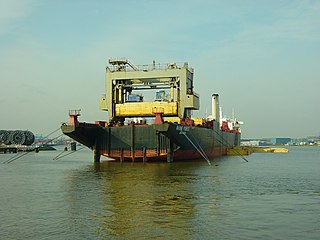
The lighter aboard ship (LASH) system refers to the practice of loading barges (lighters) aboard a bigger vessel for transport. It was developed in response to a need to transport lighters, a type of unpowered barge, between inland waterways separated by open seas. Lighters are typically towed or pushed around harbors, canals or rivers and cannot be relocated under their own power. The carrier ships are known variously as LASH carriers, barge carriers, kangaroo ships or lighter transport ships.
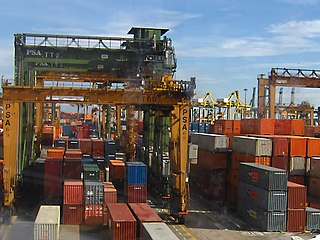
A container port or container terminal is a facility where cargo containers are transshipped between different transport vehicles, for onward transportation. The transshipment may be between container ships and land vehicles, for example trains or trucks, in which case the terminal is described as a maritime container port. Alternatively, the transshipment may be between land vehicles, typically between train and truck, in which case the terminal is described as an inland container port.
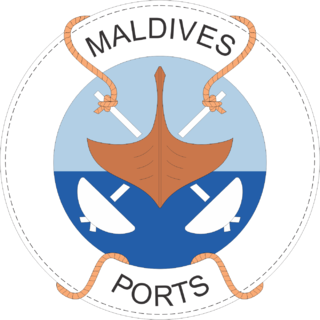
Maldives Ports Limited is a state corporation of the Maldives, created to be the sole port authority of the ports of the Maldives. It is 100% owned by the government of Maldives and is located in Malé, the principal port, major city and capital of the archipelago nation in the Indian Ocean.

Titan was a floating crane that operated in Sydney Harbour from 1919 until 1991. She was fabricated in Carlisle in the United Kingdom, then sent to Cockatoo Island Dockyard in Sydney for assembly, before entering service with the Royal Australian Navy (RAN).

Paradip Port is a natural, deep-water port on the East coast of India in Paradip, just 53 km (33 mi) from Jagatsinghpur city in Jagatsinghpur district of Odisha, India. It is at the confluence of the Mahanadi river and the Bay of Bengal, 210 nmi south of Kolkata and 260 nmi north of Visakhapatnam.

Yulius Fuchik was a Soviet and later Ukrainian barge carrier. Derivatives of the Seabee system, she and her sister ship, Tibor Szamueli, were built in the late 1970s by the Finnish state-owned shipbuilder Valmet in Vuosaari shipyard. As the demand for lighter transport fell in the 1990s, she was sold and eventually broken up in Alang in 2003.

SB Centaur is a wooden Thames sailing barge, built in Harwich, Essex, England in 1895. She was used to carry various cargoes, mainly grain, for the next 60 years. During the First World War she carried food and coal to the French Channel ports. During the Second World War Centaur was damaged when sailing to assist with the Dunkirk Evacuation. She did war work for the duration of the conflict.
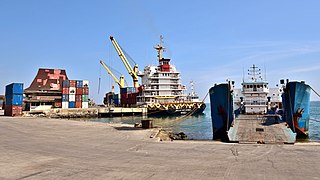
The Port of Dili is a seaport in Dili, East Timor. Prior to 30 September 2022, it was the main and only international port of entry to East Timor. On that day, its container operations were transferred to the Tibar Bay Port. Since then, the Port of Dili's facilities have been open only to domestic passenger ships and cruise ships carrying international tourists.























